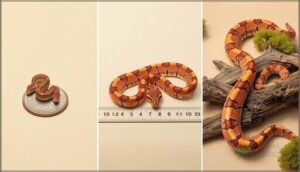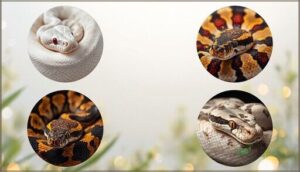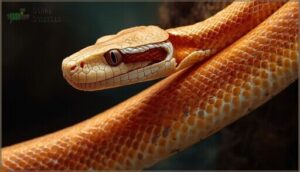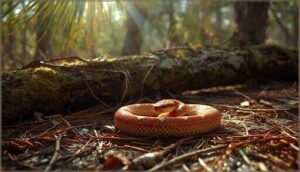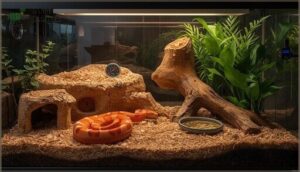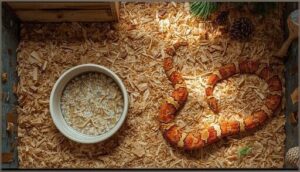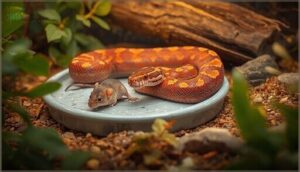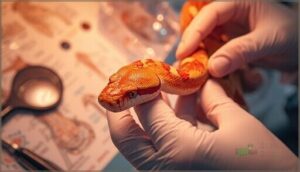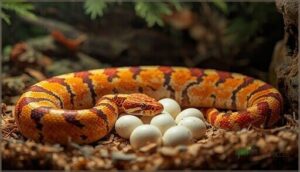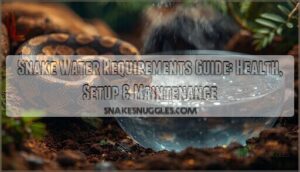This site is supported by our readers. We may earn a commission, at no cost to you, if you purchase through links.

Picture a snake so striking that collectors have named over 800 distinct color morphs, each one a reflection of nature’s creativity. Corn snakes slip quietly through leaf litter in southern forests, their orange and red scales blending in with autumn ground—right where their name comes from.
You’ll find them thriving in rocky hillsides and wooded thickets, hunting with the patience of a seasoned predator. Their gentle temperament and manageable size make corn snakes a favorite among both new and experienced keepers.
If you’re curious about what it takes to care for one, understanding their habits and needs is the best place to start.
Table Of Contents
- Key Takeaways
- What Are Corn Snakes?
- Physical Characteristics of Corn Snakes
- Natural Habitat and Distribution
- Behavior and Temperament
- Housing Requirements for Corn Snakes
- Temperature and Humidity Needs
- Substrate and Enclosure Maintenance
- Diet and Feeding Guidelines
- Common Health Issues in Corn Snakes
- Reproduction and Conservation Status
- Frequently Asked Questions (FAQs)
- How venomous is a corn snake?
- What is the biggest trouble with corn snakes?
- Is a corn snake poisonous?
- Is a corn snake a good pet?
- Do corn snakes like to be held?
- Are corn snakes aggressive?
- How long do corn snakes typically live?
- What are corn snakes native habitats?
- How often should a corn snake shed?
- How can I identify a healthy corn snake?
- Conclusion
Key Takeaways
- Corn snakes are docile, non-venomous constrictors reaching 3-5 feet in length, with over 800 color morphs available, making them ideal for beginners due to their calm temperament and manageable size.
- Proper housing requires a minimum 48″ x 24″ x 24″ enclosure with a temperature gradient of 75-85°F, humidity levels of 40-60%, and secure lids since these snakes are notorious escape artists.
- Feeding schedules vary by age, with hatchlings eating every 5-7 days, juveniles weekly, and adults every 14-21 days, using appropriately sized frozen rodents that match the snake’s mid-body width.
- With proper care including temperature regulation, appropriate substrate, and regular health monitoring, captive corn snakes typically live 15-20 years compared to only 6-8 years in the wild.
What Are Corn Snakes?
Corn snakes are medium-sized, non-venomous constrictors that have become one of the most popular pet snake species in the reptile community. Their docile temperament, manageable size, and striking variety of color patterns make them an excellent choice for both beginners and experienced keepers.
Before you bring one home, it’s important to understand what makes these snakes unique and why they’ve earned their place as a favorite among herpetology enthusiasts.
Species Overview
Corn snakes (Pantherophis guttatus) are North American rat snakes beloved for their docile nature and striking physical characteristics. You’ll find these non-venomous constrictors perfect for beginners because they’re:
- Easy to handle with calm temperaments
- Available in over 800 morph variations showcasing genetic diversity
- Beneficial pest controllers that eat rodents
- Hardy pets reaching 24-72 inches long
Their naming origins trace to corn granaries where they hunted mice. They thrive in grassy areas and rocky crevices.
Scientific Name and Classification
The scientific name you’ll encounter is Pantherophis guttatus (Linnaeus, 1766), though you might see older references using the synonym Elaphe guttata. This corn snake belongs to the family Colubridae, the largest snake classification. The genus Pantherophis—meaning “panther snake”—reflects their spotted pattern.
Their taxonomic history includes multiple reclassifications, with genetic insights now consolidating subspecies. Regional names like “red rat snake” persist throughout their range.
As nongame species, they’ve specific regulations.
History and Origin
Beyond those shifting taxonomic changes, you’ll find corn snakes (Elaphe guttata) have deep American roots. Their name origins trace to grain storage areas where rodents attracted these predators, fostering early interactions with settlers who recognized their pest control value.
Corn snakes earned their name and reputation as valued pest controllers in early American grain storage areas, forging deep roots in local history
Their evolutionary lineage spans millions of years across North America’s diverse landscapes, shaping the corn snake habitat, behavior, and characteristics you observe in today’s adaptable species. Geographic history reveals populations from New Jersey to Louisiana.
Physical Characteristics of Corn Snakes
Corn snakes have a distinctive appearance that makes them easy to identify and one of the most visually striking pet snakes you can own. Their physical traits change as they grow, and their color patterns vary widely depending on their morph.
Let’s look at the key features that define how these snakes look and develop throughout their lives.
Size and Growth Stages
Your corn snake’s journey from hatchling to adult is fascinating to watch. Hatchlings start small, measuring just 8 to 14 inches, but rapid hatchling growth means they’ll triple their length within six months.
Juvenile corn snakes reach about 3 feet by their first year, while adults measure 3 to 5 feet. Average corn snake size depends on genetics, diet, and care, with most reaching full size by age three.
Color Patterns and Morphs
You’ll find corn snake morphs in dazzling variety—over 800 distinct types exist today. Pattern inheritance follows simple Mendelian genetics, with the CLCN2 gene controlling whether you see stripes, blotches, or checks.
Morph genetics create vibrant coloration through combinations like Snow and Blizzard. Rarest morphs, including Scaleless, command $250–$400 in the morph market, while breeding trends favor compound types combining multiple genes for stunning appearance colors.
Unique Anatomical Features
You’ll notice their skeletal flexibility right away—each belly scale connects to a single vertebra, giving corn snakes that fluid, smooth glide. Their jaw kineticism lets them swallow prey three times their head width, thanks to independently moving jaw bones.
Smooth scale microstructure reduces friction during movement, while Jacobson’s organs provide sensory detection of chemical cues.
These muscular adaptations and unique features make their anatomy perfectly suited for hunting and survival.
Natural Habitat and Distribution
Understanding where corn snakes come from helps you recreate the right conditions in captivity. These adaptable reptiles occupy a surprising range of habitats across the southeastern United States, each offering specific resources they need to thrive.
Let’s look at their natural range, the environments they prefer, and how their behavior shifts with the seasons.
Geographic Range in North America
You’ll find corn snakes across the eastern United States, from southern New Jersey down to Florida and westward through Louisiana. Two subspecies exist: the typical corn snake in the southeast and the Great Plains rat snake extending from Illinois to Texas.
Snake identification varies by region, with climate influence affecting size and behavior. Florida hosts the densest populations, while habitat elevation ranges from sea level to 1,800 meters in mountainous areas.
Preferred Environments
You’ll want to understand habitat selection when setting up your corn snake enclosure. These snakes favor deciduous forests and rocky hillsides with plenty of cover—think hollow logs, leaf litter, and brush piles that meet their shelter requirements.
Microhabitat preferences lean toward soil-based substrates that hold moderate humidity, supporting their temperature gradients and environmental adaptability. They’ve even adapted to barns and suburban areas where rodents thrive.
Seasonal Behavior Changes
Think of corn snakes as living thermostats—their entire rhythm follows temperature’s lead. Activity peaks during spring’s mating season, when males roam energetically searching for partners. Summer brings intense feeding patterns to fuel growth, while autumn triggers preparation for winter’s slowdown.
Come December, brumation habits take over as seasonal changes drop temperatures, prompting your snake to seek shelter and dramatically reduce metabolic activity until spring returns.
Behavior and Temperament
Understanding how corn snakes behave in the wild helps you create a better environment for your pet and know what to expect from their personality. These snakes have distinct patterns in how they move, hunt, and interact with their surroundings throughout the day and across seasons.
Let’s look at the key aspects of corn snake behavior you should know as an owner.
Activity Patterns
Corn snakes follow a fascinating rhythm that shifts with the seasons and climate. Unlike primarily nocturnal predators, they’re diurnal and crepuscular, meaning you’ll catch them exploring mostly during the day and at twilight. Here’s what shapes their daily routine:
- Geographic variation — Southern snakes stay active longer than northern populations
- Seasonal hibernation — October to April in most regions, shorter or absent in warmer climates
- Habitat usage — Time split between basking, hunting in burrows, and climbing
- Hunting times — Peak activity at dawn and dusk when rodents emerge
- Muscle function — Juveniles prioritize speed; adults favor constriction strength
Social Structure
Unlike many species that form lasting bonds, your corn snake lives life as a true loner. These reptiles come together briefly for breeding, then return to their independent lifestyle. Their solitary behavior keeps competition low for food and territory. Seasonal influence might bring a few snakes to share a warm shelter in colder months, but don’t expect social plasticity like garter snakes show.
| Context | Corn Snake Behavior |
|---|---|
| Daily Living | Prefer independent roaming and hunting |
| Breeding Season | Males show brief mating displays and dominance |
| Group Aggregation | Weak opposite-sex preference, no lasting bonds |
| Winter Sheltering | Temporary tolerance for shared dens |
Communication Methods
Since corn snakes are solitary creatures, their communication methods aren’t chatty—they’re practical and survival-focused. Your snake relies on chemical, visual, and tactile signals to navigate its world, especially during breeding season.
Key Communication Methods:
- Pheromone signals – Males release chemical cues that females detect through their Jacobson’s organ, guiding mating behavior
- Defensive displays – Hissing, tail rattling, and S-shaped neck postures warn off threats
- Vibrational cues – Ground vibrations detected through jawbones help locate prey or sense danger
- Tactile interaction – Physical rubbing during courtship establishes boundaries and interest
- Seasonal communication – Behavior intensifies in spring breeding periods, then quiets down
Housing Requirements for Corn Snakes
Setting up the right home for your corn snake isn’t complicated, but a few key elements make all the difference between a stressed snake and a thriving one. You’ll need to think about enclosure size, security features, and the basics that keep your snake comfortable and safe.
Let’s walk through what you need to create a proper setup from the ground up.
Enclosure Size and Security
A secure Corn snake enclosure setup starts with the right enclosure size—aim for minimum dimensions of 48″ x 24″ x 24″ for adults. Climbing space matters, so taller designs boost enrichment. Lid security is essential; these escape artists slip through small gaps. Material choices, like front-opening glass, help maintenance. Cohabitation risks mean single occupancy is safest.
| Feature | Why It Matters |
|---|---|
| Minimum Dimensions | Enables movement |
| Climbing Space | Encourages activity |
| Lid Security | Prevents escapes |
| Material Choices | Eases cleaning |
Essential Enclosure Features
After locking down a safe corn snake enclosure setup, your next step is dialing in habitat requirements. You’ll need:
- Heating methods for temperature regulation
- Humidity control with accurate monitoring
- Substrate types that support burrowing and moisture
- Ventilation needs balanced for fresh air
Each feature works together, creating a stable, comfortable environment where your snake can thrive.
Recommended Decorations and Hides
When planning your enclosure setup, choose hideout boxes made of safe materials like resin or cork for easy cleaning and durability.
Tank decorations such as sturdy branches and rocks boost spatial complexity and enrichment benefits, encouraging burrowing behavior and exploration.
Place hide boxes in both warm and cool zones to support temperature regulation, mimicking natural habitat setups and keeping your corn snake comfortable.
Temperature and Humidity Needs
Keeping your corn snake comfortable starts with getting the temperature and humidity just right. These factors shape everything from their daily activity to long-term health.
Here’s what you’ll need to set up their enclosure properly.
Creating a Temperature Gradient
Ever wonder why your corn snake hugs one side of the tank? It’s all about the temperature gradient.
Set up heating requirements with ceramic or halogen bulbs for the basking spot, and use thermostats for precise control.
Monitoring tools like digital thermometers help you track health impacts—ensuring your snake can bask, retreat, and thrive in a balanced thermal gradient.
Humidity Control and Monitoring
On humid summer nights, your corn snake’s comfort depends on ideal humidity—aim for 40-60% most days, bumping up to 70% during shedding.
Place a digital hygrometer mid-enclosure and inside the humid hide for accurate readings.
Misting techniques and damp substrate help, but watch for seasonal adjustments, since winter air can dry out corn snake humidity levels quickly.
Lighting and UVB Requirements
Did you know your corn snake thrives on a steady lighting schedule? A 12-hour cycle mimics nature, while UVB benefits go beyond survival—boosting immune health and growth.
Use T5 HO UV lights for safe basking intensity, and remember annual bulb replacement. Skip direct sunlight; controlled UVA/UVB light aids natural behaviors and keeps corn snake temperature and lighting just right.
Substrate and Enclosure Maintenance
Keeping your corn snake’s home clean and comfortable starts with choosing the right substrate. You’ll also want to pay attention to how you maintain the enclosure and where you place the water dish.
Here’s what you should know before setting things up.
Safe Substrate Options
Choosing the right substrate shapes your corn snake’s world—think of it as the foundation of their comfort and health.
For safe, practical options that meet corn snake housing requirements, consider:
- Aspen shavings (low impaction risks, moderate cost)
- Coconut coir (excellent humidity retention)
- Cypress mulch (holds moisture, pricier)
- Bioactive setups (natural look, higher cleaning frequency and cost analysis)
Each benefits your corn snake’s habitat needs differently.
Cleaning and Hygiene Practices
Think of cleaning as the backbone of corn snake health—skip it, and trouble follows. Spot cleaning daily keeps aspen shavings and other substrate options fresh.
Full cleaning with a 3% bleach solution or reptile-safe disinfectant every month ensures disinfectant safety. In bioactive enclosures, maintenance shifts to regular spot cleaning and monitoring.
Water sanitation matters, especially during cleaning and maintenance routines.
Water Dish Placement
After cleaning, your water dish placement can make or break reptile care. For corn snake habitat setup, balancing humidity impact and snake safety is key. I recommend:
- Placing the dish on the cool end for spill prevention
- Elevating above substrate for cleanliness
- Using heavy ceramic for material selection
- Ensuring easy access to meet accessibility needs
These choices support overall corn snake care.
Diet and Feeding Guidelines
Feeding your corn snake isn’t complicated, but there are a few key things you’ll want to get right. Knowing what, how much, and how often to offer food makes all the difference. Here’s what you should keep in mind as you plan your snake’s meals.
Prey Types and Sizing
Across regions, corn snakes adapt their hunting behavior and snake diet to local prey nutrition, targeting rodents, birds, or amphibians as available.
In captivity, frozen rodents and pinkie mice are staple prey items. For safe captive feeding, follow sizing guidelines: offer prey about as wide as your snake’s mid-body, ensuring healthy digestion and avoiding regurgitation.
Feeding Frequency by Age
Once you’ve matched prey size, it’s time to set a feeding rhythm. Hatchling schedules run every 5–7 days, while juvenile portions shift to once a week. Adult intervals stretch to every 14–21 days, and senior adjustments may mean feeding every 10–14 days.
Seasonal feeding changes are normal—corn snake diet and feeding guidelines always flex with age, health, and activity.
Safe Thawing and Preparation
Once you’ve got your feeding schedule, safe thawing matters just as much. Refrigerator thawing keeps frozen rodents cold and limits pathogen risks. Next, a brief water bath warms prey to near body temperature.
Always source from trusted suppliers and use feeding tongs—never your hands. Following corn snake feeding guidelines protects both you and your pet from unnecessary health risks.
Common Health Issues in Corn Snakes
Keeping your corn snake healthy means knowing what problems to watch for. There are a few common issues that can affect their well-being.
Here’s what you should keep an eye out for in your pet’s care routine.
Signs of Illness
Ever wondered how to spot trouble before it spirals? Regarding corn snake health and issues, keep your eyes peeled for these five warning signs:
- Lethargy signs—unusual inactivity.
- Feeding refusal—ignoring meals.
- Abnormal shedding—stuck skin or eye caps.
- Respiratory distress—wheezing or open-mouth breathing.
- Physical abnormalities—weight loss, scale rot, or foul odors.
Recognizing these common corn snake health problems early helps you act fast.
Preventive Care and Vet Visits
When caring for corn snake health and issues, annual exams and regular parasite screening are your best line of defense. Since there are no vaccinations, focus on habitat hygiene and injury prevention.
Veterinary care helps catch common illnesses early, so bring enclosure photos and note changes. Consistent preventive care makes a real difference in avoiding potential health issues and keeping your snake thriving.
Shedding and Skin Health
During shedding, your corn snake’s skin health hinges on humidity effects and mechanical aids. Watch for shedding indicators like cloudy eyes and stuck eye caps—these signal behavioral changes and possible health issues. If you notice patchy shed or retained skin, act fast with:
- Warm water baths for stuck shed
- Humid hides on the warm side
- Regular checks for healthy, complete shedding
Reproduction and Conservation Status
Understanding how corn snakes reproduce and their conservation status can help you care for them responsibly. These topics also shape the way you set up their enclosure and support their natural behaviors.
Here’s what you need to know before choosing the right setup.
Breeding Cycle and Egg Laying
Did you know corn snake reproduction hinges on spring’s warmth? Breeding seasonality shapes clutch size, with females laying 6–31 leathery snake eggs after a 25–50 day gestation. Incubation needs are precise—82°F and moist substrate support egg viability. Maternal care ends at laying; females recover with water and food, leaving hatchlings to emerge independently.
| Breeding Seasonality | Spring–Early Fall |
| Clutch Size | 6–31 Eggs |
| Incubation Needs | 82°F, Moist Substrate |
| Maternal Care | None Post-Laying |
Hatchling Development
Did you know corn snake hatchlings are independent from the start? After an incubation period of 60–79 days, you’ll see:
- Hatchling Size: 8–12 inches long, fully formed.
- First Shed: Occurs within a month, lasting 5–7 days.
- Early Feeding: Pinkie mice every 3–5 days.
- Growth Rate: Steady, influenced by incubation temperature and prey size.
Conservation Efforts and Legal Protection
Did you know local laws protect corn snakes more than you might expect? Habitat preservation is front and center, with strict regulations targeting illegal collection and road mortality.
Conservation efforts include population monitoring and the protection of rare morphs. These steps help make certain snake conservation bolsters broader ecosystem preservation, keeping corn snakes—and the habitats they rely on—safe for future generations.
Frequently Asked Questions (FAQs)
How venomous is a corn snake?
Despite centuries of folklore suggesting otherwise, corn snakes possess zero venom and cause no medical impact. These nonvenomous constrictors rely on constriction, not toxins, making bite severity minimal and public safety concerns unnecessary.
What is the biggest trouble with corn snakes?
The biggest trouble you’ll face comes down to Escape Prevention—they’re notorious escape artists.
Respiratory infections, mouth rot, and feeding risks follow closely, demanding vigilant health management and proper husbandry to keep your snake thriving.
Is a corn snake poisonous?
Let’s clear the air: corn snakes are completely nonvenomous snakes. They lack venom glands and pose no toxic threat.
Bite severity is minimal—just superficial punctures. You won’t face saliva risks or copperhead confusion with proper snake identification.
Is a corn snake a good pet?
Yes, corn snakes make excellent pets for beginners. Their docile temperament, low maintenance needs, and manageable size create ideal conditions for those learning pet snake care.
They’re affordable, hardy, and tolerate regular handling well.
Do corn snakes like to be held?
Most corn snakes tolerate handling after acclimation, though they don’t seek affection. Regular sessions reduce stress signs like hissing or tight coiling.
Individual variation exists—some welcome interaction, others prefer minimal contact.
Are corn snakes aggressive?
No, these nonvenomous snakes aren’t aggressive. Bite incident rates stay under 10% with proper handling.
Defensive triggers like stress cause most problems, but gentle, consistent interaction reduces defensive behavior considerably in captivity versus wild settings.
How long do corn snakes typically live?
In captivity, these reptiles generally live 15 to 20 years with proper care, though the record reaches 32 years. Wild corn snakes average only 6 to 8 years due to predation and environmental challenges.
What are corn snakes native habitats?
Stretching like a patchwork quilt across the Southeast, their territory spans from New Jersey to Florida and west to the Mississippi River, favoring warm pine forests, rocky hillsides, and grassy plains where prey thrives.
How often should a corn snake shed?
Your snake’s shedding cycle depends on age. Hatchlings shed every 4–6 weeks, juveniles monthly, and adults every 2–3 months. Humidity, diet, and health affect frequency. Watch for eye caps and incomplete shed issues.
How can I identify a healthy corn snake?
You can tell a lot about health by looking at your snake’s eyes, skin, and behavior signs. Clear eyes, smooth shedding quality, and strong activity levels point to good body condition and clinical absence of common illnesses.
Conclusion
Corn snakes have truly earned their stripes as one of the most rewarding reptiles to keep. With proper housing, consistent temperature gradients, and a steady feeding routine, you’ll watch your snake thrive for decades. Their calm nature and straightforward care requirements make them ideal for beginners and veterans alike.
Now that you understand their needs—from substrate choices to shedding cycles—you’re ready to provide a healthy, enriching environment where your corn snake can flourish.

